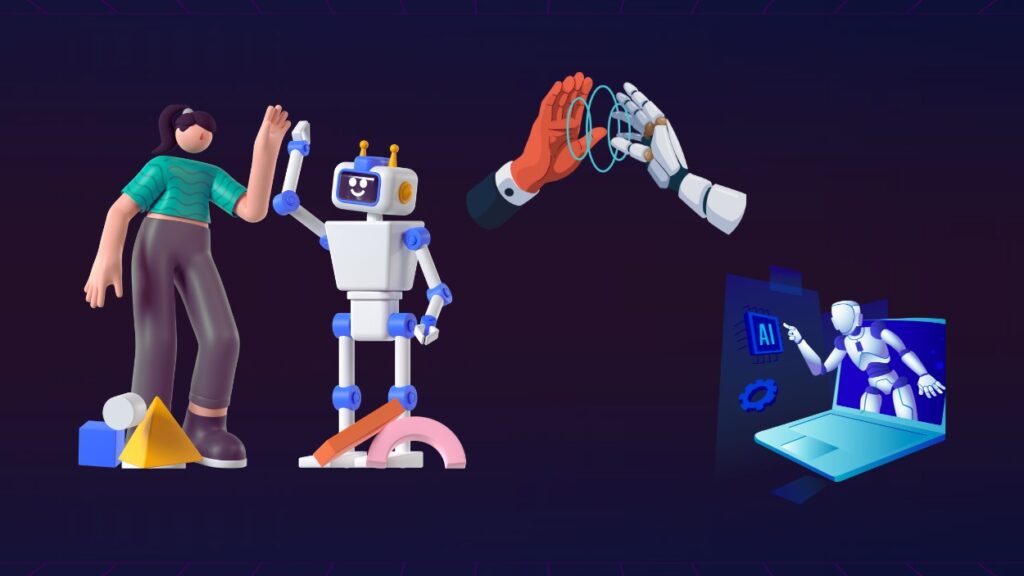Artificial intelligence is reshaping robotics with tangible momentum. From guiding factory robots to powering humanoid helpers, AI is boosting efficiency and autonomy across sectors. For instance, UCL and Google DeepMind’s RoboBallet coordinates eight robot arms through 40 tasks, surpassing traditional systems by a wide margin. Meanwhile, Boston Dynamics’ Atlas now learns walking and manipulation through one general model. Together, these developments mark steps toward more agile, intelligent robots.
Editor’s Choice
- $72.3 billion: Projected size of the global AI in robotics market in 2025.
- 34%: Share of service robots equipped with AI within the total robotics market in 2025.
- 21.7%: Portion of global AI robotics patents filed by the U.S. in 2025.
- 41%: Asia-Pacific’s share of AI-driven robotics development in 2025.
- $25.02 billion: Estimated size of the AI in robotics market in 2025 according to Mordor Intelligence.
- 13.1% CAGR: Growth rate forecasted for AI in the robotics market between 2025 and 2030.
- $16.5 billion: Record global value of industrial robot installations in 2025.
Recent Developments
- RoboBallet, developed by UCL and Google DeepMind, plans eight-arm workflows through 40 tasks, far outperforming older models managing five robots for only ten tasks.
- Atlas humanoid now uses a unified AI model to walk, manipulate, and even recover dropped objects through emergent behavior.
- UBS sees a surge of humanoid robots: projected 2 million in workforce by 2035, scaling to 300 million by 2050, the market could hit $30–$50 billion by 2035, and $1.4–$1.7 trillion by 2050.
- Nvidia introduced Jetson Thor, a robotics platform with 7.5× AI compute, 3.1× CPU speed, and 2× memory, poised to power next-gen autonomous machines.
- Google DeepMind’s Gemini Robotics models enable robots to act with dexterity and adaptability, even folding origami, bridging perception and physical action.
- South Korea formed the K‑Humanoid Alliance to develop a commercial humanoid that can lift 20 kg and move at 2.5 m/s by 2028.
- Agility Robotics deployed Digit robots in logistics (e.g., with GXO and Amazon), and wages per robot usage reach $30/hour, aiming for human-robot collaboration by late 2025.
- New trend: increased autonomy with AI enabling real-time adaptation, pattern recognition, and planning across robotic systems.
AI in Robotics Overview
- AI in robotics is projected to hit $72.3 billion in 2025.
- Service robots with AI now represent 34% of the overall robotics industry.
- Asia-Pacific leads with a 41% share in AI-driven robotics growth.
- The U.S. accounted for 21.7% of AI robotics patents filed globally.
- Mordor Intelligence reports $25.02 billion market size for AI robotics in 2025.
- CAGR estimated at 13.1% between 2025 and 2030 for the AI-enabled robotics market.
- Industrial robot installations reached a high of $16.5 billion in 2025.
- The broader robotics market (beyond AI) was around $94.5 billion in 2024, with a 14.7% CAGR projecting to over $372 billion by 2034.
Global AI in Robotics Market
- In 2023, the global AI in robotics market stood at $12.3 billion.
- By 2024, it expanded to $15.8 billion, showing early acceleration.
- In 2025, the market value reached $20.2 billion.
- By 2026, it climbed further to $25.9 billion.
- In 2027, the market crossed the $30 billion threshold, hitting $33.2 billion.
- By 2028, it rose sharply to $42.5 billion.
- In 2029, the market hit $54.5 billion, doubling its size in just four years.
- By 2030, it surged to $69.8 billion.
- In 2031, the market value reached $89.4 billion.
- By 2032, the size expanded further to $114.6 billion.
- Finally, by 2033, the global AI in robotics market is projected to reach $146.8 billion, reflecting a CAGR of 28.12% over the forecast period.
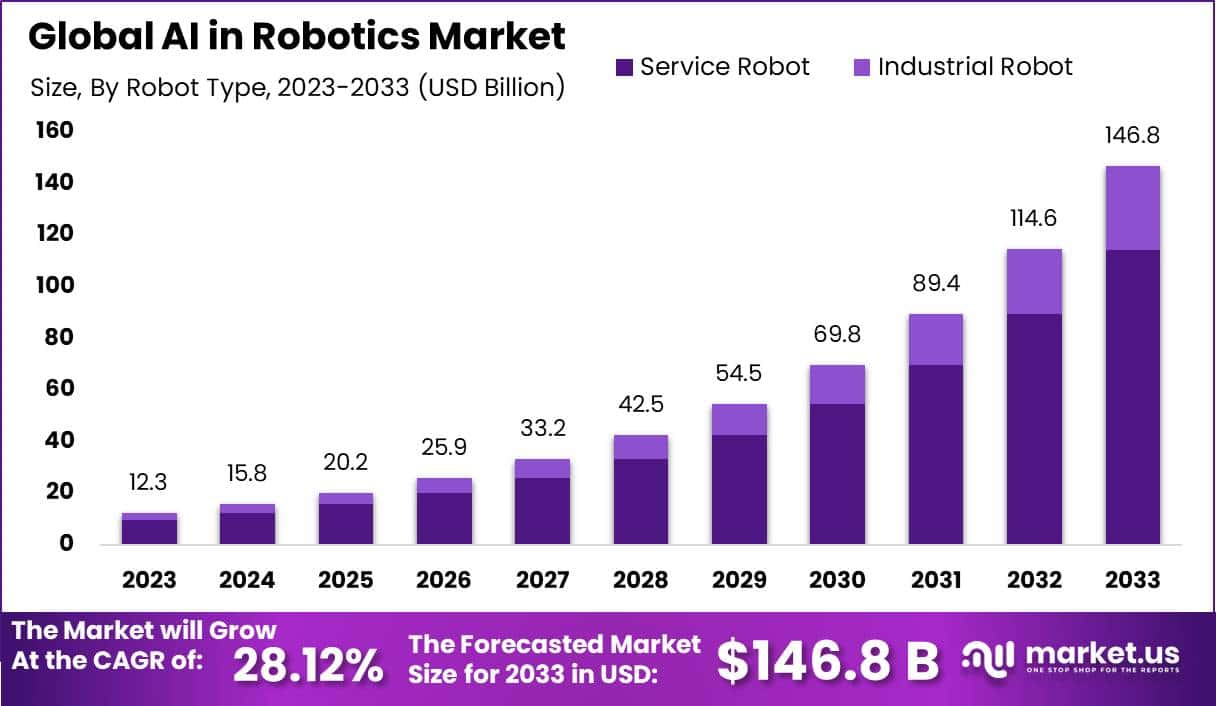
Industry Adoption Rates
- 21.7% of global AI robotics patents originate in the U.S., indicating strong innovation activity.
- Asia-Pacific commands 41% of AI-driven robotics development regions.
- South Korea launched the K‑Humanoid Alliance, signaling collaborative public–private adoption initiatives.
- Agility’s Digit is already performing logistics tasks in real workplaces (e.g., Amazon, GXO).
- Over 50 events on robotics at NY Tech Week 2025 reflect rising interest and adoption in urban innovation hubs like New York City.
- Google DeepMind’s Gemini Robotics is now in trials with partners like Agility Robotics and Boston Dynamics.
Key Application Areas
- Manufacturing: RoboBallet optimizes robotic task coordination, reducing planning from days to seconds.
- Humanoid tasks: Atlas now navigates, manipulates, and adapts using one AI model.
- Logistics and warehousing: Digit robots assist in tasks at Amazon and GXO warehouses.
- Global workforce: UBS forecasts 2 million humanoid robots in use by 2035, rising to 300 million by 2050.
- Smart robotics platforms: Jetson Thor enables real-time AI processing for complex physical tasks.
- Research alliances: South Korea’s K‑Humanoid project aims for high-performing commercial humanoids by 2028.
- General-purpose models: Gemini Robotics empowers robots to understand context, interact, and act with agility.
- Urban innovation: Robotics featured prominently across New York Tech Week, signaling broad sector momentum.
Industrial Robotics Statistics
- Amazon alone deployed ~800,000 mobile robots in its fulfillment centers by 2024.
- South Korea leads in robot density with 1,012 robots per 10,000 employees, China follows with 470, surpassing Germany’s 429.
- Cobots made up 11% of all industrial robots installed in 2023, with annual sales nearing $3 billion and growth expected at +30% annually.
- Industrial automations such as RoboBallet are advancing robotics coordination with AI-driven multi-arm setups, boosting efficiency in manufacturing.
- ABB expanded its U.S. robotics hub by $20 million in Michigan, boosting capacity by 30% and adding training for 5,000 employees annually.
- Specialized task-focused robots saw over $2.26 billion in funding in Q1 2025, with 70% of capital directed toward purpose-built systems.
Regional Market Statistics
- South Korea is the leader in industrial robot density at 1,012 units per 10,000 workers, followed by China at 470, overtaking Germany’s 429.
- The Asia-Pacific region accounts for 41% of the AI-driven robotics market development in 2025.
- Nearly 46% of global robotics revenue in 2023 came from the Asia‑Pacific.
- In the U.S., the AI robot market is estimated at $6.36 billion in 2025, projected to grow to $38.9 billion by 2034, a 22.05% CAGR.
- North America’s advanced robotics market exceeded
- 18.34 billion in 2024, with a projected CAGR of 20.28%.
- The cognitive robotics market is valued at $6.6 billion in 2025, expected to reach $19 billion by 2037, 10% CAGR.
- Predictive AI in robotics is forecast to rise from $4.87 billion in 2024 to $19.9 billion by 2034, 15.1% CAGR in 2024. Asia‑Pacific held a 36.4% share, and China’s share was set to grow at a 17.4% CAGR.
- Taiwan’s TAIROS exhibition drew 320,000 attendees in 2024 and remains a key regional robotics showcase.
Global AI Robot Market Growth By Region
- The global AI robot market will expand from $4.5 billion in 2022 to $55.5 billion in 2032, representing more than a 12x increase in value over the decade.
- Asia-Pacific consistently leads the market, growing from $2.0 billion in 2022 to $22.0 billion in 2032, capturing the largest regional share throughout the period.
- Europe and North America also show strong growth, with Europe rising from $1.0B to $10.0B, and North America from $0.8B to $9.0B by 2032.
- The Rest of the World grows steadily, from $0.7B in 2022 to $7.5B in 2032, reflecting expanding adoption in emerging markets.
- By 2030, the market will surpass $31 billion, more than doubling from its 2026 size of $11.7 billion.
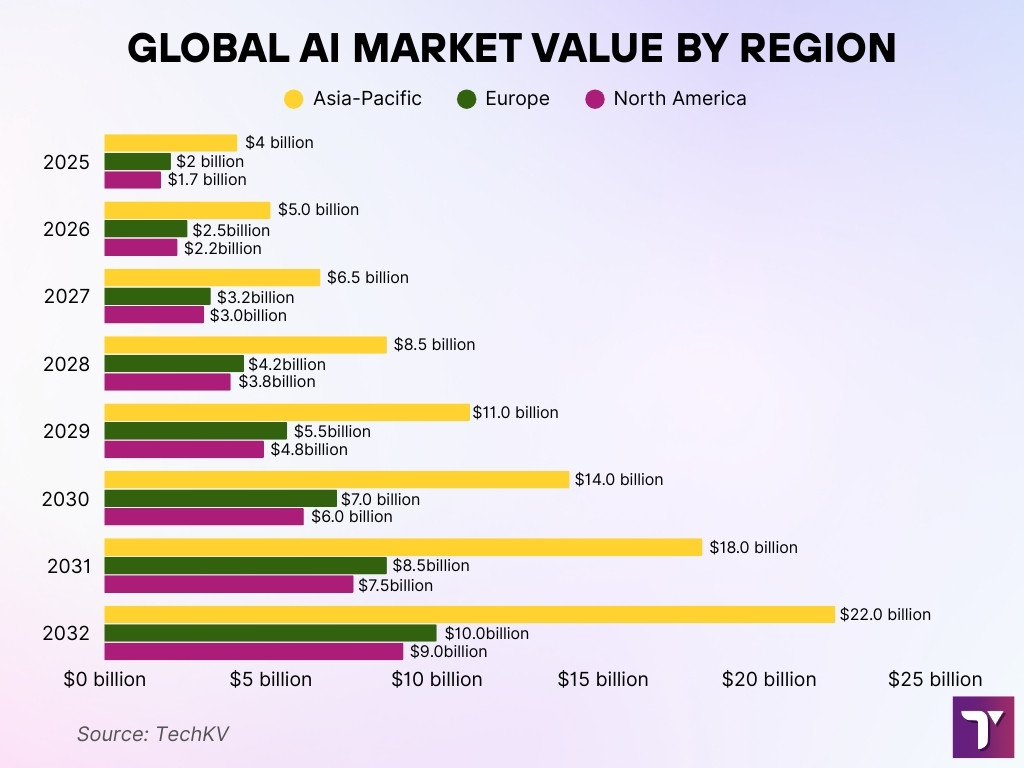
Manufacturing
- RoboBallet shrank workflow planning from days to seconds, orchestrating 8 robot arms across 40 tasks without collisions.
- Meanwhile, ABB’s Michigan center expansion highlights the rising demand for AI-driven automation in logistics, healthcare, and construction.
- In addition, specialized robots targeting single tasks, like those from Ati Motors and Diligent Robotics, attracted over $2.26 billion in Q1 2025 investment.
- Furthermore, manufacturing cobots have become more accessible, selling for under $3 billion annually and growing at 30% year-over-year.
- At the same time, human-centric safety innovations, such as 97% accurate thermal sensors for cobots, are enhancing collaboration in factory environments.
- Moreover, AI now supports manufacturing by monitoring processes, managing supply chains, and coordinating logistics, boosting overall productivity.
- Looking ahead, the global advanced robotics market, closely tied to manufacturing, is projected to grow from $53.74 billion in 2025 to $280.01 billion by 2034, at a 20.13% CAGR.
Healthcare
- AI-driven hospital robots increased deployment by 38% in 2025 over the previous year.
- ABB’s robotics hub now supports healthcare robots performing tasks like pharmacy automation and DNA testing.
- Customized healthcare bots like Moxi, by Diligent Robotics, manage supply logistics and have reached product-level profitability.
- Apptronik’s latest funding round of $350 million supports expanding humanoid robots into elder care and healthcare applications.
- AI in robotics also bolsters diagnostics, with global AI in healthcare expected to exceed $180 billion by 2030, and algorithms reducing diagnostic error rates by up to 85%.
- Task-focused bots excel in healthcare, delivering supplies and samples efficiently and safely.
Swarm Robotics Statistics
- The global swarm robotics market is expected to reach $1.9 billion in 2025, growing at a 25.6% CAGR, to $14.7 billion by 2034.
- Alternative projections estimate $1.63 billion in 2025, rising to $7.69 billion by 2032, 24.8% CAGR.
- Another forecast estimates $1.05 billion in 2025, and $11.46 billion by 2035, 27.0% CAGR.
- A contrasting model puts the market at $861 million in 2024, $1.05 billion in 2025, and forecasts $2.997 billion by 2030, 23.1% CAGR.
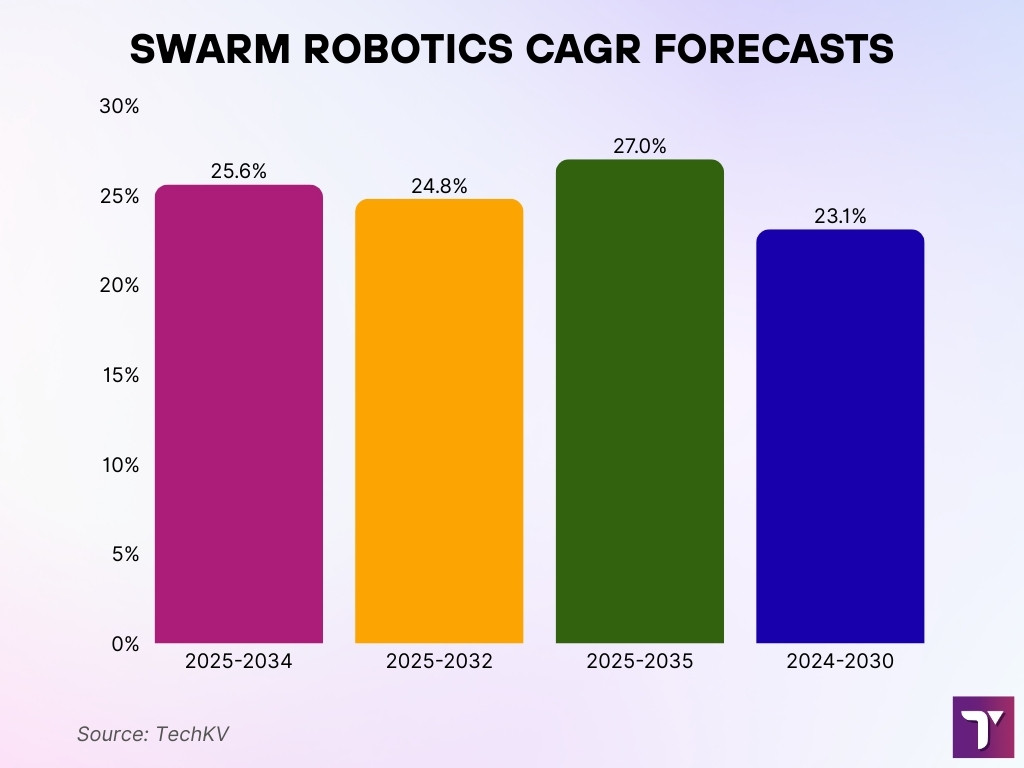
- The U.S. led North America’s swarm segment, holding over 66% share in 2024, driven by investments in sectors like logistics, agriculture, and e-commerce.
- Europe’s swarm market is expected to grow at a 26.4% CAGR from 2025 to 2033, backed by EU-funded programs in infrastructure and safety robotics.
- Asia-Pacific shows the fastest regional growth at 33.1% CAGR in the same period, with drone swarms used extensively for spraying, soil scanning, and irrigation.
Agriculture
- AI-enabled agricultural robots are forecasted to reach $2.3 billion by 2026.
- FarmWise’s Titan FT‑35 uses AI and computer vision for mechanical weeding, without chemicals, reflecting the shift toward sustainable automation.
- Agricultural robot sales jumped 21% in 2023, totaling approximately 20,000 units deployed.
- Smart farming methods are helping reduce water waste by up to 30%, while boosting crop yields.
- AI in the agriculture market size is projected to reach $4.7 billion by 2028, growing at a 23.1% CAGR.
- The broader smart agriculture sector is expected to grow to $23.38 billion by 2029.
- Agricultural 4.0 initiatives aim for a 70% increase in food production by 2050, powered by AI, IoT, and automation.
Transportation
- In 2025, 1.2 million AI-enabled autonomous drones were shipped, a 127% increase over the prior year.
- Task-specific robotics continues to attract investment in transport applications, notably in logistics and mobility support.
- Amazon reduced order-fulfillment costs by 25%, and anticipates $10 billion in annual savings by 2030, thanks to robot deployment.
- Global mobile robot market hit $ 4.5 billion in 2023, rose to $5.5 billion in 2024, and is set for 20%+ annual growth through 2030.
- Cobots used in logistics support tasks like loading/unloading, packing, and inspection, making transport robotics safer and more flexible.
Smart Home Robotics Statistics
- AI voice assistants (e.g., Alexa, Google Assistant) are now embedded in over 600 million smart home devices.
- Domestic cleaning robots (e.g., Roomba) reached 22% YoY growth in 2024, with 37 million units sold.
- By 2030, AI-integrated smart home devices are projected to exceed 1.2 billion active installations.
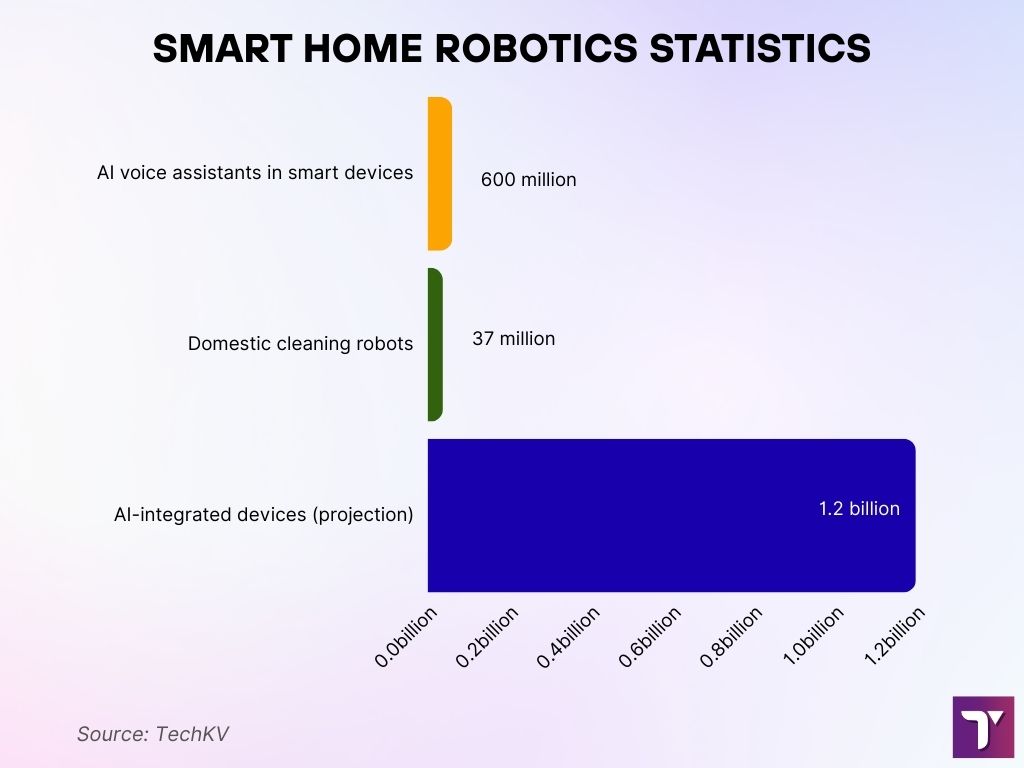
- Smart home robot sales hit $9.5 billion globally, with 29% of devices AI-powered.
- Home health robots saw 45% growth in 2025, including companion and monitoring robots.
- 70% of smart home buyers in 2025 rated AI integration as a top factor in purchase decisions.
- LG and Samsung are incorporating context-aware AI into robotic vacuums, fridges, and care assistants.
- AI pet care robots are gaining traction, with startups reporting 280% investment growth in 2024.
Service Robotics Statistics
- By 2025, over 16 million service robots will be deployed globally, with 57% AI-enabled systems operating across industries like retail and healthcare.
- In 2024, around 36.8 million robots were operational worldwide, of which 98.9% were service robots.
- AI-powered retail service robots have generated approximately $3.6 billion in revenue.
- 4.3 million eldercare robots are active worldwide, highlighting the rising demand in that sector.
- Autonomous Mobile Robots (AMRs) in warehouses surged by 60% from 2020 to 2022, underscoring rapid adoption.
- Service robots have improved factory safety, reducing accidents by up to 25%.
- AI-enabled service robots now fuel hundreds of millions in operational and commercial growth, particularly in hospitality and healthcare.
Collaborative Robots (Cobots) Statistics
- In Q1 2025, cobots accounted for 11.6% of all robots ordered and 6.8% of total robotics revenue in North America.
- In the first half of 2025, 3,085 cobots were ordered in North America, valued at $114 million.
- Globally, cobots comprised 11% of all industrial robots installed in 2023, with annual sales approaching $3 billion and projected >30% yearly growth.
- Despite a low in shipment growth at 13.8% in 2024, demand is expected to rebound with 20.6% growth in 2025.
- The global cobot market rose to $2.14 billion in 2024, with an expected 31.6% CAGR from 2025 to 2030.
- Another outlook puts the cobot market value at $1.42 billion in 2025, growing to $3.38 billion by 2030, 18.9% CAGR.
- Cobots are popular with SMEs due to affordability, flexibility, and easy adoption, benefiting from initiatives like Industry 5.0 and “cobot-as-a-service” models.
Future Projections for AI in Robotics
- Industry estimates place the future robotics market, including autonomous, collaborative, and humanoid types, on a 30% CAGR through 2030.
- If swarms follow projected growth (e.g., $1.9 billion to $14.7 billion by 2034), AI-robotics sectors will remain major growth engines well into the next decade.
Frequently Asked Questions (FAQs)
The AI robots market was estimated at $20.82 billion in 2025, projected to reach $ 149.34 billion by 2032, growing at a 32.5% CAGR from 2025-2032.
In 2023, the market was about $12.77 billion, expected to reach $124.77 billion by 2030, at a 38.5% CAGR from 2024 to 2030.
The mobile robotics software market is projected at $4.4 billion in 2025, rising to $23.2 billion by 2035, with a CAGR of 18.0%
The global service robotics market is estimated at $62.85 billion in 2025, expected to reach $212.77 billion by 2034, growing at a 15% CAGR.
Conclusion
To begin with, AI is reshaping robotics on every front, from collaborative bots reshoring workflows to humanoid edges pushing into logistics and public spaces. Moreover, adoption is not just climbing; it’s accelerating across manufacturing, healthcare, transportation, and agriculture. In addition, service robots now number in the tens of millions, while swarm robotics is on an upward trajectory. At the same time, human–robot interaction is evolving through new trust models, tactile learning, and contextual interfaces. Meanwhile, emerging innovations like Helix and global competitions are shaping AI robots that feel both powerful and relatable.
